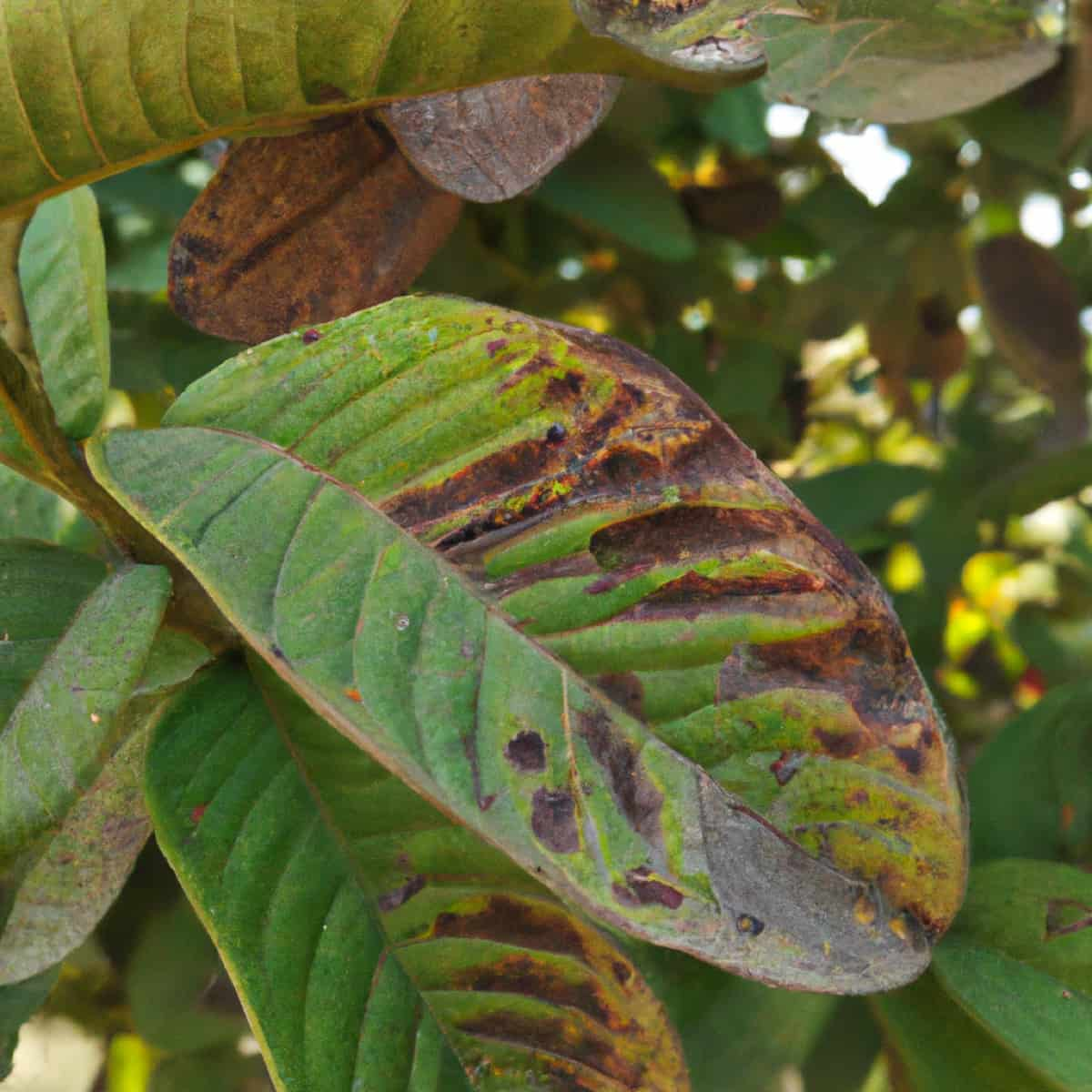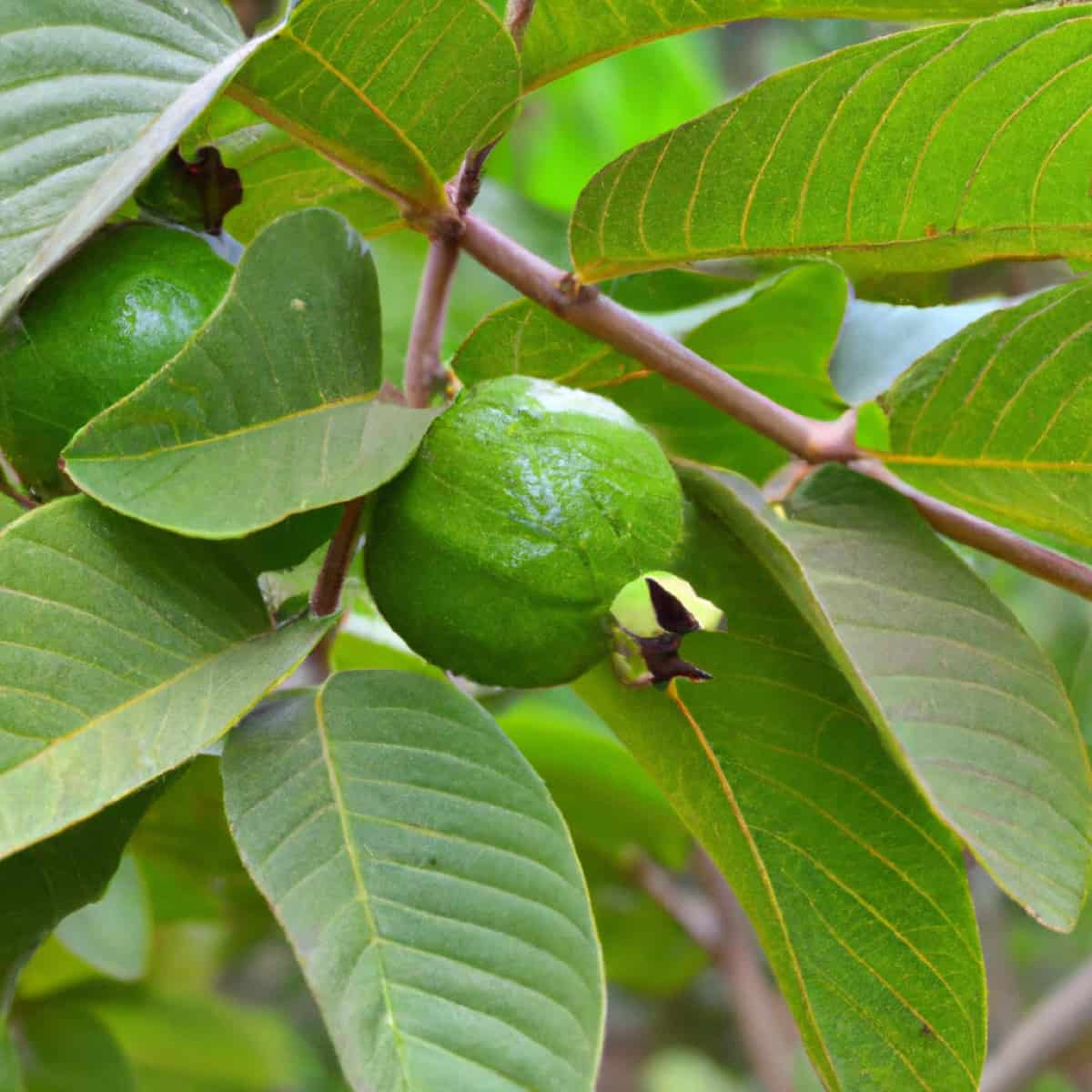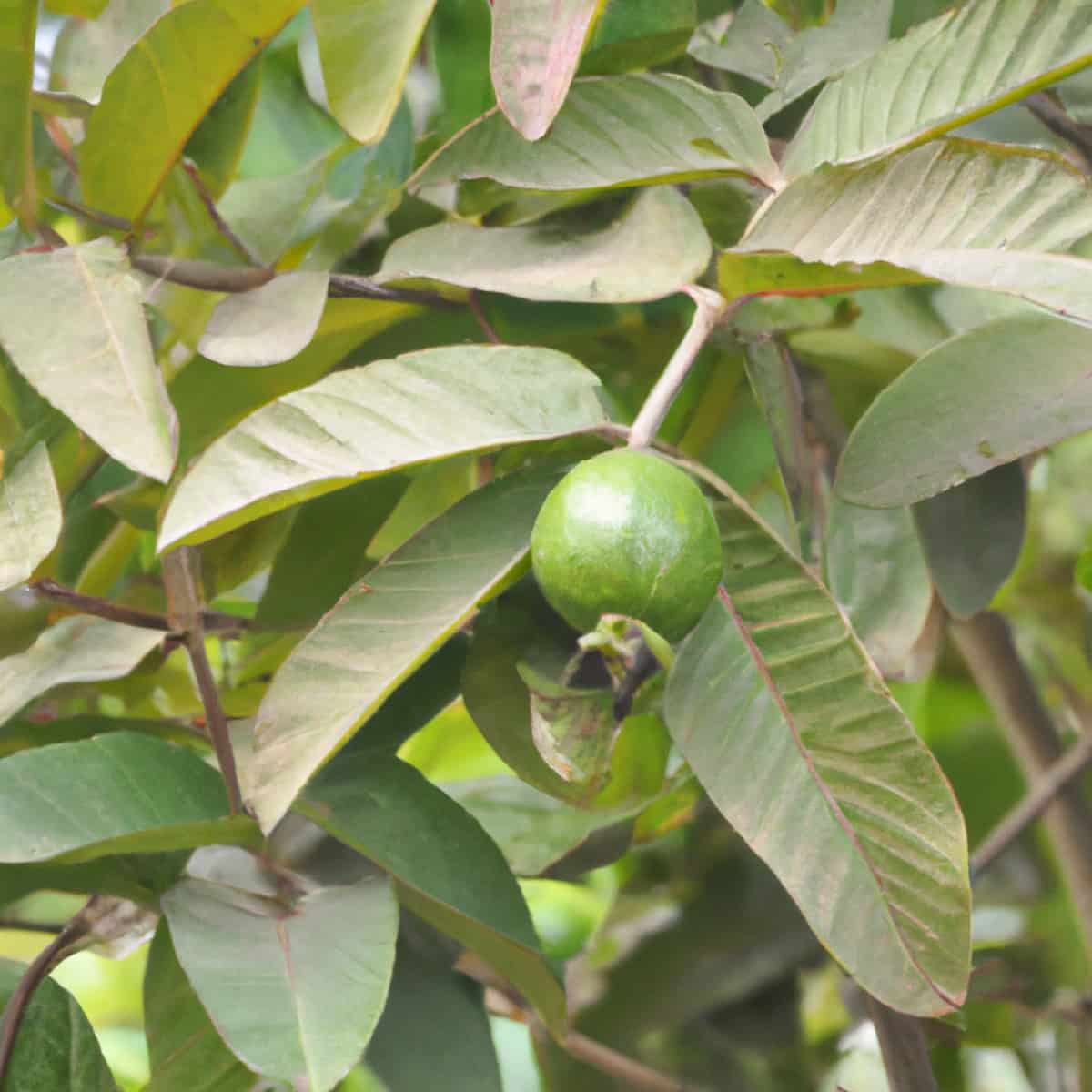A common problem home gardeners and commercial cultivators face is that brown spots on guava tree leaves can be a real concern. They often signal various issues, such as fungal diseases or pest infestations, compromising the tree’s health and the fruit’s quality. These brown spots, along with similar issues like black spots on guava fruit and leaves and the presence of white fungus on the guava tree, must be addressed promptly and effectively.

Natural treatments offer many benefits for guava tree care and can aid in resolving such issues. We can mitigate and control these issues without harming the environment by utilizing organic home remedies and natural pesticides for guava trees. This comprehensive guide will dive into the causes of such discoloration and various natural remedies to combat these issues in an eco-friendly and efficient manner.
How to Treat Brown Spots on Guava Tree Leaves
Causes of Brown Spots on Guava Tree Leaves
Brown spots on guava tree leaves can result from several factors, including fungal diseases, pest infestations, and environmental stressors. These spots often start small but can gradually expand, covering a significant portion of the leaf surface and leading to premature leaf fall. The fungal infections responsible for this issue are typically more prevalent during the rainy season when the weather is humid.
In addition to brown spots on the leaves, such diseases can also cause brown spots on guava fruit, thus affecting the quality of the harvest. Pests such as aphids, mites, and mealybugs can also cause brown spots on guava tree leaves. They suck the sap from the leaf, causing it to turn brown and fall prematurely. The entire tree may be affected in severe cases, leading to a drop in fruit yield and tree vigor. Further, environmental stressors like inadequate watering, nutrient deficiency, or exposure to harsh weather conditions can cause similar symptoms.
Natural Remedies for Brown Spots on Guava Leaves
To tackle these issues, several natural remedies can be employed. One effective remedy is using natural pesticides for guava trees, such as neem oil. When diluted with water and sprayed onto the leaves, the oil acts as a natural deterrent for pests, preventing them from causing further damage. Moreover, the antifungal properties of neem oil can help control fungal diseases responsible for brown and black spots on guava leaves and fruit.
A homemade garlic spray is another excellent natural remedy for brown spots on guava leaves. Garlic contains sulfur, which has fungicidal properties. Spraying a solution of crushed garlic and water on the affected leaves can significantly reduce the spread of fungal diseases. Furthermore, this spray will also deter pests, helping maintain your guava tree’s overall health.
Organic Treatments for Guava Tree Leaf Discoloration
Organic treatments for guava tree leaf discoloration offer an eco-friendly alternative to chemical pesticides and fungicides. Compost tea, for example, is an effective treatment that can boost the tree’s overall health while preventing the spread of diseases. The beneficial microbes in compost tea outcompete harmful pathogens, thus preventing them from spreading and causing further damage to the tree.
In case you missed it: Natural and Organic Ways to Treat Guava Tree Leaf Curl: Fix with Effective Home Remedies

In addition, homemade sprays made from baking soda or vinegar can also effectively treat fungal diseases. These sprays alter the leaf surface’s pH level, making fungi inhospitable to thrive. Spraying these solutions on the affected areas of the guava tree can help control the spread of diseases, leading to healthier leaves and fruit.
Home Remedies to Fix Guava Leaf Browning
Home remedies can also play a significant role in treating guava leaf browning. For instance, a simple soapy water solution can be sprayed on the leaves to eliminate pests. The soap breaks down the waxy exterior of pests, causing them to dehydrate and die. For fungal issues, a solution of milk and water sprayed on the leaves can help. The enzymes in milk can effectively inhibit the growth of fungi, aiding in the control of diseases causing brown spots on guava leaves and fruit.
Effective Ways to Treat Guava Leaf Spot Naturally
Regular inspection and early detection of issues are some of the most effective ways to treat guava leaf spot naturally. Regularly inspecting the guava tree’s leaves, branches, and fruit can detect early signs of disease or pest infestation. Removing affected leaves or branches promptly can prevent the spread of diseases.
Natural treatments, like using beneficial insects like ladybugs and lacewings, can also be helpful. These insects prey on harmful pests, keeping their population under control. Moreover, maintaining proper watering and fertilizing schedules can also help keep your guava tree healthy and resistant to diseases and pests.
Eco-friendly Solutions for Brown Spots on Guava Tree Leaves
There are numerous eco-friendly solutions for brown spots on guava tree leaves. One solution is using plant-based pesticides, such as pyrethrum, derived from chrysanthemum flowers. It acts as a natural neurotoxin to pests, effectively controlling their population. Companion planting is another eco-friendly solution to deter pests and attract beneficial insects. For example, planting marigolds near your guava tree can repel aphids and other pests, while plants like dill and fennel can attract beneficial insects.
Herbal Treatments for Guava Leaf Discoloration
Herbal treatments can also be effective against guava leaf discoloration. For example, a spray made from a decoction of chives can be used to treat fungal diseases. Chives contain a natural fungicide that can inhibit the growth of fungi. Similarly, a spray made from a decoction of tansy can deter pests due to its strong smell.
Safe and Natural Methods to Cure Guava Leaf Brown Spots
Safety should be the top priority when dealing with guava leaf brown spots. Safe and natural methods that can be employed include manually removing pests and diseased leaves and using traps for larger pests like snails and slugs. Proper hygiene and sanitation practices are also crucial. Regularly cleaning the area around the guava tree and removing fallen leaves or fruit can prevent the buildup of pests and diseases.
DIY Treatments to Fix Brown Spots on Guava Tree Leaves
Several DIY treatments can fix brown spots on guava tree leaves. For instance, you can make a homemade spray by mixing cider vinegar with one part water. This mixture can help control the spread of fungi, thus reducing leaf browning. Similarly, a spray made from chili and garlic mix can deter pests due to the strong smell and taste.
In case you missed it: 1 Acre Guava Cultivation Cost and Profit Analysis: Production Economics and Project Report

Holistic Approaches to Address Guava Leaf Browning Naturally
A holistic approach to naturally addressing guava leaf browning involves caring for the entire ecosystem around the guava tree. This includes maintaining healthy soil, encouraging biodiversity, and practicing crop rotation.
Healthy soil contains ample organic matter and beneficial microorganisms, aiding nutrient uptake and bolstering disease resilience. Encouraging biodiversity in your garden can help balance the ecosystem, reducing the population of harmful pests. Crop rotation, on the other hand, can disrupt the life cycle of pests and diseases, thereby reducing their impact on the guava tree.
Conclusion
Addressing issues like brown spots on guava tree leaves, black spots on guava fruit, and white fungus on guava trees is possible and preferable for the tree’s long-term health and the environment. These methods may require more effort, but the results are worth it. Remember, healthy guava trees produce healthier and tastier fruits!
- Ultimate Guide to Ossabaw Island Hog: Breeding, Raising, Diet, and Care
- Ultimate Guide to Juliana Pig: Raising Facts, Size, Diet, Care, and Lifespan
- Raising Lleyn Sheep: Disadvantages, Price, Uses, Characteristics, and Care
- Ultimate Guide to Meishan Pig: Breed Facts, Breeding, Raising, and Care
- Ultimate Guide to Teacup Pigs: Raising, Diet, Lifespan, Cost, and Care
- Guide to Raising Poll Dorset Sheep: Facts, Profile, Characteristics, Uses, and Care
- Ultimate Guide to Bighorn Sheep: Characteristics, Diet, Lifespan, Breeding, and Lifecycle
- Ultimate Guide to Raising Katahdin Sheep: Farming Facts, Breed Profile, Uses, and Care
- Ultimate Guide to Raising Oreo Cows: Belted Galloways Farming Facts, Profile, Uses, and Care